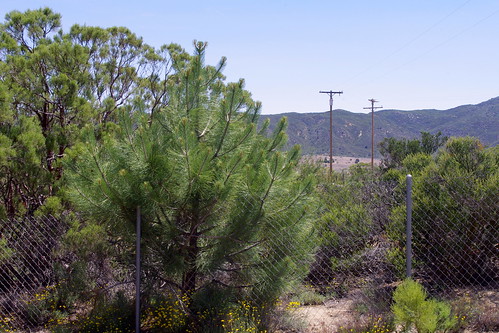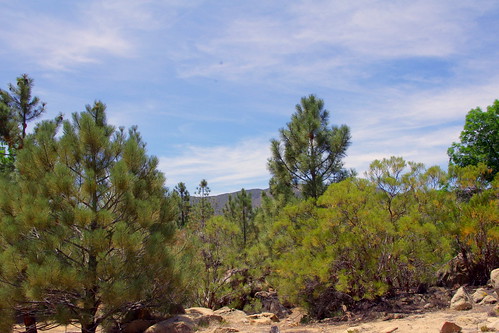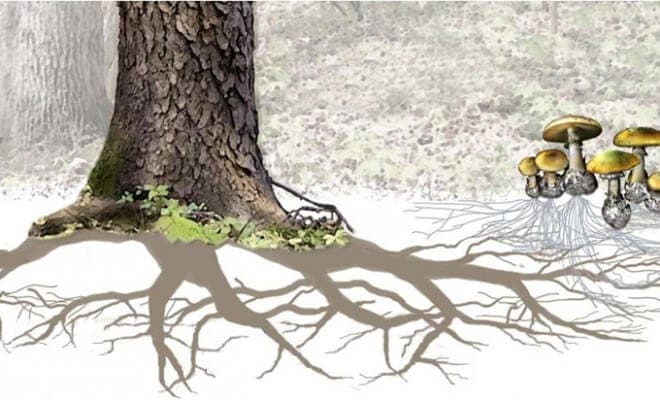 |
| www.fragmentedforests.org |
 |
| credit: Mine - Foothill Pine (Pinus sabiniana) |
 |
| by Bob Harms - University of Texas |
 |
| Photo: Mine |
Believe it or not, this tree was a two year old planted in the winter of 2000/2001. It was watered regularly the first couple of months to simulate a wet period, then left to it's own. It stayed small for 3 or four years then shot up like a rocket. The tree is almost as tall as the old growth Redshank which is in the background. Burnt Valley and Lookout Mountain are in the background. You should also take special note that this soil here is extremely shallow with broken decomposed granite rock. I did break through this rocky layer when I created the original planting hole with a heavy steel bar at about two foot down. I reused the same soil as back fill without ANY amendment material added. I never ever use amendment, just fungal inoculum and mulch on the very surface. The soil for me was not a problem as the chaparral was itself old growth and it's massive height indicated it's roots had spiraled through the fractured rock with ease into deeper moister soil layers. The picture below is of the larger Jeffrey & Coulter Pines planted in between the Redshank we planted at Dawson's old place in Terwilliger which is also much hotter and far more lower in elevation than my place on top of Table Mountain. Still, notice the success. Inoculated with PT ecto-mycorrhizae, irrigation in early to middle 1980s and left alone thereafter. Once again, the Redshank Chaparral is the real hero here.
 |
| Photo: Mine |
~~~~~~~~~~~~~~~~~~~~~~~~~~~~~~
Shifting Gears Here
 |
| Microbial breakdown of rocks magnified |
The main message found at that site is that beneficial fungi, algae, bacteria and other microbes can actually unlock nutrients like Nitrogen and Phosphorus which are locked up in a structural form which makes them unavailable to all plants. By taking advantage of already existing cracks and other fractures, this actually leads the way for tree and shrub roots to actually intrude into deeper layers of sub-soils. This in turn allows plants with exceptional ability with regards a phenomena known as Hydraulic Descent to be able to pump water from the surface during the rainy season to these deeper layers to be utilized later during the hotter summer months. Any excess water will be added to deep underground aquifers which have suffered as a result of human misuse and abuse. Aquifers mean higher water tables for which even deserts may thrive with certain plants like Mesquite or Palo Verde designed to withstand those harsh environmental conditions. Below is a beautifully illustrated animation of what takes place all the time within rocky soil structures.
One thing is for sure, we truly don't know the extent to which hydraulic descent of moisture through deeper large old growth roots into much deeper layers of sub-soils actually works and which plants perform a better job at doing this. Still, knowing such valuable information would in of itself be invaluable to the re-forester when selecting just the right plant components for making a success of any ecosystem reestablishment. As stated at the beginning, most of the valuable old growth woodlands of most all ecosystems have only remnants of their former glory and it's a pity because observation is key to any understanding how such plant mechanisms function. We know what happens to geology when vegetation is severely removed. Rains come and wash away much of the valuable topsoil with it's healthy biological components. Soils develop into desertification in many areas and the soil pores close up so tightly that they just seem to fossilize into a type of rock. Any badlands are a prime example. In many cases rebuilding of such an area with re-vegetation in mind requires drastic measures. Perhaps it would be necessary to apply organic matter to the topsoil layers, but only after you perform a soil fracturing task otherwise utilized by those who drill deep holes for planting small explosives for percolation improvement through otherwise impermeable rock/soil layers. Rain alone is not going to percolate into deeper layers of Earth's sub-soil all by itself without the assistance of vegetation. References for last resort of soil impact fracturing: Here
 |
| credit: Greenbelt Hydraulic Descent during plant dormancy |
 |
| Add caption |
 |
| Credit: Wayne Ranne - Jodhpor India, Acacia tree stabilized Sand Dune |
Now you can go ahead and read the article from the link below on how Tree roots 'are natural thermostat' (which is a little vague) about how deep roots of trees are carbon sinks in sub-soils, or how Mushrooms are going to save the world, but none of the wishful speculation (though interesting) backed by patents and grandiose hopes of making a fortune with these schemes is going to replace REAL OUTDOORS education and Practical Application of what is observed. Below here is a further explanation of the actual heroes of bedrock breakdown and soil creation along with how they all work in conjunction with all other components within every ecosystem.
Climate News Network: Tree roots 'are natural thermostat'
~~~~~~~~~~~~~~~~~~~~~~~~~~~~
Of Further and Related Interesting Note:
 |
| Credit: Greener Ideal (February 24, 2014) Can Mushrooms Fight Climate Change ? |
"Plants sequester carbon dioxide, but when they die, that carbon enters the soil—a lot of it. Globally, soil is the biggest single terrestrial reservoir of carbon, far more than the amount of carbon contained in living things and in the atmosphere combined. (On a planetary scale, the oceans hold by far the most carbon.) As the dead plant matter is broken down by microbes in the oil, that carbon is released back into the air. The rate at which that carbon leaves the soil can obviously have a major impact on the amount of carbon in the atmosphere, which in turn helps drive climate change."Of course when you first read this, it seems like the blame for carbon release is by the decomposing of vegetation which causes the CO2 gases. But the real damage is man made synthesized unnatural aerosols into our atmosphere, not swamp gases from nature which have been going on for 10s of 1000s of years with no problem until now. Lately, I have seen some articles blaming trees for the release of their own VOCs (natural aerosols) which mix with industrial particles and cause hazy polluted skies. However, trees have been doing this with no problems until humans stepped up to the plate.
"One of the limits to the growth of those decomposing microbes is the availability of nitrogen in the soil. Living plants and soil microbes compete for nitrogen, and the less nitrogen is available to the microbes, the slower decomposition is—and the more carbon remains in the soil, instead of outgassing into the atmosphere. This is where the fungi come in. Most plants have a symbiotic relationship with mycorrhizal fungi: the fungi extract the nitrogen from the soil, and make it available to the plants through their roots. But according to a new study in Nature, one major type of the symbiotic fungi can extract nitrogen much more quickly than other types—and that in turn slows the growth of the competing microbes and leaves much more carbon locked away in the soil."Keep in mind also that even if fungi and bacteria are real heroes, they are also subject to the same deadly chemical pollution which kills other living things. Acid rain from industrial regions is also a killer of these organisms. As tough as we all would like to believe the microbial world is, they too have limits as to what they can withstand, often times it's the negative pathogenic microbial types which flourish as a result of the imbalance. This in turn creates the unfortunate and unfair bad reputation against all things microbial.
Researchers from the University of Texas, Boston University and the Smithsonian Tropical Research Institute ran computer models on data from more than 200 soil profiles from around the world. They found that soils dominated by ecto- and ericoid mycorrhizal (EEM) fungi contain as much as 70% more carbon than soils dominated by arbuscular mycorrhizal (AM) fungi. That’s because the EEM fungi produce more nitrogen-degrading enzymes, which allows them to extract more nitrogen from the soil. They essentially outcompete the soil microbes, which slows down their ability to decompose dead plant matter and return carbon from the soil to the atmosphere. “This analysis clearly establishes that the different types of symbiotic fungi that colonize plant roots exert major control on the global carbon cycle, which has not been fully appreciated or demonstrated until now,” said Colin Averill, a graduate student at the University of Texas and the lead author of the paper.
That relationship between the different types of fungi and plants is so important for the carbon cycle because it’s independent of temperature, precipitation, soil clay content and all the other variable factors that can influence plant growth and soil content. Perhaps unfortunately for us, though, AM fungi symbiosis is far more common, occurring in approximately 85% of plant families, while just a few plant families have a symbiotic relationship with EEM fungi. That could change as the composition of forests change, however, but we wouldn’t know the effects until scientists add the role of the different kinds of symbiotic fungi into global climate models, which they have yet to do."
“This study shows that trees and decomposers are really connected via these mycorrhizal fungi, and that you can’t accurately predict future carbon cycling without thinking about how these two groups interact,” said Averill. “We need to think of these systems holistically.”
~~~~~~~~~~~~~~~~~~~~~~~~~~~~
Some Conclusions
 |
| "Planes, Trains and Automobiles" |
Humans: "Top of the morning to you Researcher, is there something we can help you with ?"
Researchers: "What the heck are you doing to your environmental surroundings ?"
Humans: "Well we've had a few disastrous industrial science mishaps happen recently ?"
Researchers: "Do you have any idea how accelerated you've pushed the natural world to the point of total breakdown ?"
Humans: "Well It's hard to say with any degree of accuracy just exactly how far we've run things into the ground."
Researchers: "Do you feel this planet is still safe enough to live on ? You've pushed things to the limit, are almost out of fuel and there are no foreseeable Services for the next 100 years"
Humans: "Well, yeah. we can buy that. Sure. You'd know better than us, especially since our weather mechanism thermostat's been melted down with global warming."
Researchers: "Do you feel this planet's life sustaining mechanisms are intact and still safe enough for sustaining life ?"
Humans: "Yes, we do. The Earth's no longer as pretty as it once was, but it will get you where you want to go."
Researchers: "You've got no rainfall, no clear skies, failing economies and no properly functioning weather mechanisms, is that about correct ?"
Humans: "No not a one, However our Laptops, TV and iPads still work. Funny as that may seem, and also on that weather thing, we've been told that GMOs and Geoengineering are going to save everything. And you, anyone who doesn't believe those things will problem solve for us are, well, just anti-science"
Okay, Okay, enough of the snarky superciliousness!
Well, I'd post other references, but you know, it would be water off a Duck's back!

Hi Kevin,
ReplyDeleteI stumbled about your fascinating blog while googling Redshank trees. We are considering purchasing property in nearby Chihuahua Valley. Beautiful Redshank, Manzanita, Sage, etc. are thriving on the land. We want to clear a portion of the chaparral to plant an apple orchard but are concerned the soil is too shallow. But after reading about your tree planting success I'm feeling more optimistic. Do you have an opinion on growing apples on land described as "Tollhouse rocky coarse sandy loam"?
Thanks!
I'll actually be over there at Anza and Ranchita come this next month from May 22 to June 12th. We fly into L.A. from Sweden and rent a car and head for El Cajon. Maybe I could come by and look at the location. Chihuahua Valley has so many soil types. Yes rocky and shallow on the hills, but depending on the size of your Redshank, maybe easy to penetrate for rootsystems of apple trees. If I were you, I would purchase standard trees and forget the semi-dwarf. The standard trees will have larger extensive root systems and grow far deeper than the other retail nursery trees for home gardens in the cities and commercial farms. I'd also look for hierloom varieties which might work better in such a tough climate zone. although things have change drastically with climate change. Chihuahua also gets good summer thunderstorms.
DeleteThis more than likely is what your soil looks like if it's on any of the surrounding hills bordering Chihuahua Valley
DeleteTollhouse Rocky Sandy Loam
-
I really appreciate the helpful info and offer! Please let me know if my email with more details didn't make it through.
ReplyDeleteYou might try my Facebook page and leave a private message:
Deletehttps://www.facebook.com/EarthsInternet
-